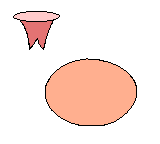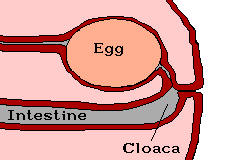

In books on poultry you can find how the egg is formed in the hen and how the young develops within. But almost nothing is written about oviposition. In wildlife films on TV you see birds nesting, brooding, the chickens hatching and being fed by their parents, but never I saw a bird laying an egg.
So I looked for myself. It is not easy to see what really happens, and I did not understand what I observed. So I asked the Poultry Research Institute in Beekbergen for advice. Mr. Teunis showed me a video, explained the process and introduced me to the literature.
It appeared to be far more interesting than I supposed at first. In the following, I will try to describe and explain what a laying hen does, five, six, even seven times a week.
Chickens never lay more than one egg per day. As a rule, chickens lay in the morning, but each day a little later. Sometimes the last egg of a series is produced in the early afternoon. When it gets too late, they take the next day off. My five commercial hybrids will sometimes lay for a series of 30 days or more.
Our Perspective on Laying Eggs (own observations, video Spelderholt):
1. The hen approaches the nest in a very hesitant way, and finally enters. There she sits quiet for a long time, often for half an hour or more. She closes an eye or calmly puts a straw on her back, but finally she gets more exited. Now and then, the hen raises her tail and spreads the feathers of her bottom. These movements increase gradually.
2. Under her tail, between the feathers, is a small opening in the form of a horizontal slit, about an inch wide. It is surrounded by a ribbed rim, with skin and feathers further outside. It is called the vent.
![]()
3. Suddenly the hen stands up with her feet wide apart, tail raised, bottom feathers spread out, and back feathers upright. As her vent opens a little, you begin to see a red membrane.
![]()
4. As the hen lowers her bottom, her vent widens rapidly and the rim is stretched further. The membrane forms a pinkish dome around the egg which is not yet visible at this stage.
5. The vent is now wide open and the ribbed rim has become narrow and far stretched. Through the opening bulges a pink hemisphere of tissue revealing distinct blood vessels. Its top is pointed downward where a new opening arises. The egg appears as a much lighter-colored disk. Even brown eggs are much lighter than the surrounding membrane.

6. The hen strains at intervals. Each time, the egg comes a little further out. As it does, the membrane opens to form a red collar around the wider, middle portion of the egg. The membrane will protrude a little ways from the ribbed rim.

7. The moist egg pops out. Sometimes it will come out blunt end first, sometimes pointed end first. For a few seconds after the egg is laid, a small red cone still remains outside, but it is retracted almost immediately and the vent is closed again. The bird stands high above the egg and rests, beak open and panting after the heavy work.

The entire process (from rising to dropping the egg) is quite fast and is finished within half a minute. Therefore, it is hard to observe. After a while, the hen looks back, inspects the egg with her beak and leaves the nest under loud cackles. The hen then eats and drinks and goes her usual ways. She seems to have forgotten her egg completely.
The Hen's Perspective on Laying Eggs (Wieckmann, 1896; Grzimek, 1964):
 1. Chickens, as well as other birds, have a common opening
for reproduction, and for the evacuation of stools and urine. This opening
is called the "vent". They do not have a bladder because their urine is not
a fluid. It is a white paste, called urates, that you can observe surrounding
the droppings. The intestine, ureters and oviduct come together into a common
chamber called the cloaca. This is a rather dirty place, whereas the egg
is always clean and almost sterile when laid.
1. Chickens, as well as other birds, have a common opening
for reproduction, and for the evacuation of stools and urine. This opening
is called the "vent". They do not have a bladder because their urine is not
a fluid. It is a white paste, called urates, that you can observe surrounding
the droppings. The intestine, ureters and oviduct come together into a common
chamber called the cloaca. This is a rather dirty place, whereas the egg
is always clean and almost sterile when laid.
 2. The hen
turns part of the cloaca and the last segment of the oviduct inside out,
"like a glove." The described red membrane is then everted inside of these
organs. The egg emerges far outside, at the end of the bulge. So it cannot
contact the walls of the cloaca and get contaminated by stools or urine.
Moreover, the intestine and inner part of the cloaca are kept shut by the
emerging egg, and their contents cannot leave when the hen strains to deliver
the egg. Therefore, eggs are always clean as they are laid. However, sometimes
a hen, stomping around the nest with dirty feet, will get the egg dirty
anyway.
2. The hen
turns part of the cloaca and the last segment of the oviduct inside out,
"like a glove." The described red membrane is then everted inside of these
organs. The egg emerges far outside, at the end of the bulge. So it cannot
contact the walls of the cloaca and get contaminated by stools or urine.
Moreover, the intestine and inner part of the cloaca are kept shut by the
emerging egg, and their contents cannot leave when the hen strains to deliver
the egg. Therefore, eggs are always clean as they are laid. However, sometimes
a hen, stomping around the nest with dirty feet, will get the egg dirty
anyway.
Why Chickens Leave the Nest
All chickens lay eggs in a series - never more than one per day. If the eggs are not collected, and a sufficient number of eggs are allowed to remain in the nest, the hen may stop laying eggs and start brooding. When the hen leaves the nest after laying an egg, it cools which suspends the development of the embryo inside. If the ambient temperature remains between 45F and 65F, the embryos will remain viable for as long as two weeks. When the hen becomes broody and sits on her eggs for three weeks, all of the eggs will hatch at about the same time. This is why it is important for the hen to leave the nest after laying.
Breaking Broodies
When we remove the eggs, the hen supposes: "There are not yet enough," and continues to lay. The hens of some breeds will get broody anyway after some time. This condition can be cured by placing the hen in a "broody pen". This is a small cage, hung in the hen house. The cooling of the bottom, the swinging movements, and the lack of eggs to sit on are said to cure this condition. The broodiness trait has been removed from most commercial laying breeds through selection. The modern laying hen has delegated her responsibility of hatching, raising, and educating chicks to humans. In nature, the poor creatures would soon become extinct.
The Story Behind the Hen's Cackle
Wild chickens are forest animals. They live in small groups called flocks. They scratch in the dirt and forage for things to eat. While one hen sits on the nest to lay, the group may wander away through the undergrowth searching for food. The hen's cackle serves to renew the contact with the group as if to yell "where are you?". The cock (with the other hens) answers "here we are!".
References:
1. Own observations.
2. Video and explanation by Mr. Teunis, Het Spelderholt, Beekbergen.
3. Tukker, J.G. & P.E. Rijpma, 1953. Het Ei bij de pluimveehouder en
bij de verzamelaar. 79 pp.
4. Grzimek, B. & F. Pusch, 1964. Das Eierbuch. 7-e Aufl., 1964, 220 pp.
(the figures on p.3).
5. Wickmann, H., 1896. Die Lage des Vogeleies im Eileiter vor und während
der Geburt. Journ. f. Ornith. XLIV, 81-9